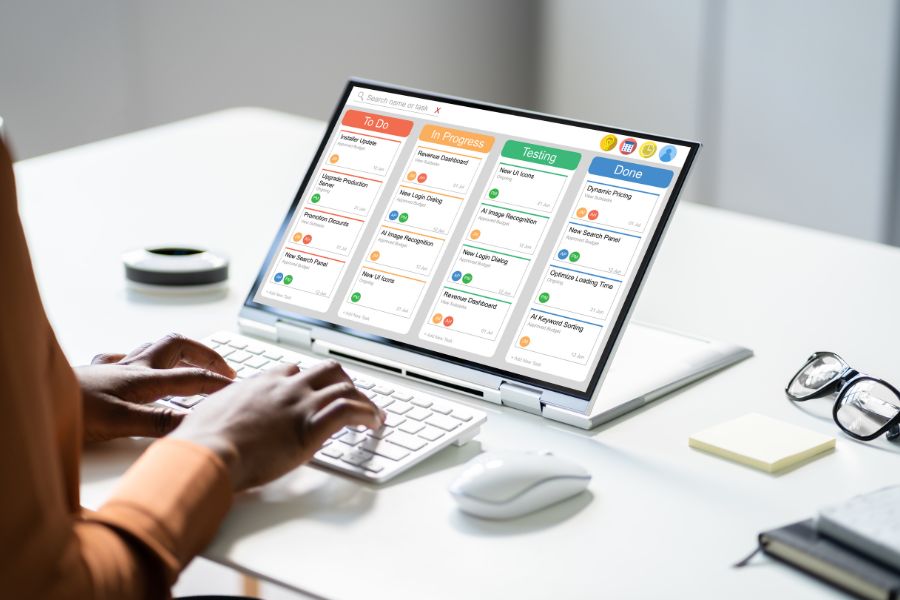Digital customer experience (or digital CX for short) is no longer a new concept; it’s an essential element of modern business strategy. As customers increasingly interact with brands online, delivering a seamless and engaging digital customer experience has become paramount. This blog explores what digital CX entails, its importance, and how to optimize it to foster customer satisfaction and loyalty.
What is digital CX?
56% of CEOs reported that digital enhancements have contributed to revenue growth. Multi-channel customers spend 4% more in-store and 10% more online than single-channel customers. Each additional channel used leads to increased customer spending.

The digital customer experience includes all interactions a customer has with your brand through online channels, such as social media, live chat, email, your website, and mobile apps. These virtual touchpoints shape customers’ overall perception of your brand.
Managing the digital customer experience goes beyond ensuring individual digital channels function well. It’s not solely a marketing or sales responsibility. Customers expect seamless access and personalized interactions throughout their entire journey across both digital and non-digital channels.
To succeed in digital customer experience, you must be aware of all digital touchpoints shared with customers across platforms and continuously improve the experience within and between these touchpoints.
The Importance of a Seamless Digital CX
For businesses
From a business perspective, the sheer number of digital channels available and the rapid pace at which users switch between them during a single journey can be overwhelming. Customer journeys are intricate, with shoppers moving between channels multiple times as they progress from awareness to consideration to purchase.
However, from a customer’s viewpoint, it’s not complicated at all. They don’t distinguish between online and offline, owned and non-owned, marketing and eCommerce. What guides their journey is their task or goal, and they expect seamless movement across channels to achieve it.
Adopting a customer-centric mindset is crucial for developing an effective omnichannel experience. This means treating channel switching and touchpoint transitions as incidental to user goals and needs. Whether a customer interacts with your brand on an in-store tablet, a third-party reseller’s website, your app, or in a shopping mall, they should encounter a consistent and recognizable presence that allows them to continue their journey smoothly.
Seamless experiences benefit both customers and businesses:
- Increased spending: According to a Harvard Business Review study, omnichannel customers spend an average of 4% more in-store and 10% more online.
- Higher retention: Brands with strong omnichannel customer engagement strategies retain an average of 89% of their customers, compared to just 33% for companies with weaker strategies.
For customer experience programs
Consumers are increasingly turning to digital support, with web and mobile self-service usage surpassing phone interactions with agents. Adopting an omnichannel mindset in your Customer Experience program is now more crucial than ever. Customers switch channels to find information, make purchases, and solve problems. Brands must eliminate internal silos to ensure seamless and cohesive cross-channel experiences.
The consequences of failing to meet customer expectations are significant:
- Financial impact: Experiences that fall short of expectations cost businesses up to $4.7 trillion annually.
- Customer dissatisfaction: The Global CX Trends Reports reveal that many customers believe significant improvements are needed:
- 29% of consumers want major improvements in the online resources provided by businesses.
- 27% seek significant enhancements in the buying process.
The Customer Journey Stages to Consider in the Digital Experience
To enhance digital CX, consider these seven key stages in the customer lifecycle:
1. Awareness
This initial stage involves capturing the attention of potential customers. It’s about making your brand known and ensuring it stands out in a crowded marketplace. Effective awareness strategies include leveraging various marketing channels and optimizing visibility.
Action:
Make it easy for new customers to find you and ensure they hear positive things. Engage with media and influencers to generate authentic social reviews and mentions. Optimize your web pages for SEO to improve search rankings and visibility.
2. Discovery
In this stage, potential customers begin to explore your brand more deeply. They look for more information about your products or services and start to form opinions based on what they find on your digital platforms.
Action:
Simplify navigation and access to your digital touchpoints. Offer in-app trials of your product or service. Gather insights on how customers engage with your site or apps, understand their intentions and pain points, and use this data to enhance the digital customer experience and resolve common issues.
3. Evaluate
Customers compare your offerings with those of competitors, evaluating features, benefits, and reviews. This stage is critical as it influences their decision to choose your brand over others.
Action:
Highlight what differentiates your offerings from those of competitors. Actively manage and respond to reviews about your customer experience. Focus on reducing the cost to serve, increasing conversions, and minimizing customer effort. Use real-time customer behavior data to dynamically optimize the customer journey.
4. Conversion
The customer decides to purchase. This stage involves ensuring the transaction process is smooth, secure, and free of obstacles that could lead to abandoned carts or lost sales.
Action:
Address common barriers to conversion, such as hidden fees or poor navigation. Ensure the payment process is secure and straightforward. Communicate effectively about the delivery process to manage customer expectations, ensuring it is safe, secure, and timely.
5. Experience
After making a purchase, the customer’s experience with your brand continues. This stage focuses on ensuring customer satisfaction and fostering ongoing engagement.
Action:
Use digital channels to foster loyalty and advocacy. Keep customers informed about new features through social media and provide how-to guides or use case ideas via web and mobile apps. Turn satisfied customers into brand advocates post-purchase.
6. Support
Effective customer support is crucial for maintaining satisfaction. Customers expect quick and efficient resolutions to their issues, often preferring digital self-service options.
Action:
Offer robust digital support channels, as 90% of consumers expect online self-service portals. Implement AI-powered chatbots and digital contact centers to enable self-service and rapid issue escalation, enhancing satisfaction and loyalty.
7. Buy Again
Encouraging repeat purchases is key to long-term success. Satisfied customers are more likely to return, provided they feel valued and receive personalized recommendations.
Action:
Encourage happy customers to share reviews online, influencing others in the awareness and discovery phases. Use customer preferences and behavior data to recommend personalized products or deals, increasing the likelihood of repeat purchases.
Understanding customers’ preferences and behaviors is essential to delighting them at each stage. Collecting customer information is not enough; enable a system of action by delivering the right information to the right person at the right time. Integrate experience data (X-data) with operational data (O-data) on a single platform for a holistic view of your customer. This approach ensures any changes to your digital CX are based on tangible facts, priming them for maximum success.
Best Practices for Creating Great Digital Customer Experiences
Incorporate these best practices into your digital customer experience management program to ensure success:
1. Drive Improvements and Standardization Across the Omnichannel Experience
Ensure consistent quality across all digital touchpoints. Whether customers are reading a delivery slip, downloading your app, or calling a branch, their experience should be seamless and uniform.
Consistency fosters trust and reliability, making it easier for customers to interact with your brand.
2. Take a Long-Term Mindset
Develop a long-term strategy focused on continual improvements aimed at increasing customer lifetime value. Recognize that results may not be immediate and require leadership buy-in.
This approach is not just about changing processes but transforming the organizational culture to prioritize customer experience.
3. Close the Loop
Follow up with customers who had negative experiences using closed-loop feedback. Prioritize high-value customers for this approach, using ticketing software to alert relevant staff to address issues promptly.
This can turn negative experiences into positive ones, strengthening customer relationships and demonstrating your commitment to customer satisfaction.
4. Be Transparent
Communicate your efforts to improve digital customer experiences to your audience. Let customers know when their feedback leads to changes, demonstrating that you value their input.
This transparency encourages more feedback and builds trust, showing customers that their voices are heard and acted upon.
5. Look to Continually Improve
Regularly test the entire customer journey to identify common pain points. Implement systems to address these issues and ensure a consistent, seamless experience. Continuously analyze and refine the digital customer journey using methods like A/B testing, post-transaction feedback, and usability testing.
This iterative approach helps maintain a high standard of customer experience.
6. Be Personal
Treat all channels as equally important and ensure each meets customer needs effectively. Personalize interactions to enhance the customer experience, regardless of the channel they choose.
Tailored communications and personalized recommendations can significantly enhance customer satisfaction and loyalty.
Following these best practices can create a robust digital customer experience management program that enhances customer satisfaction and loyalty. Ensuring a consistent, transparent, and personalized approach across all digital touchpoints will lead to a seamless and satisfying customer journey.
Best practices for improving digital CX
Here are some foundational steps to enhance digital customer experience through your program:
1. Understand the How and Why of CX
Leverage experience data (X-data), such as CSAT (Customer Satisfaction) scores and Ease of Use metrics, to understand the human factors driving customer behaviors. Combine X-data with operational data (O-data) to gain powerful insights into customer interactions. This combination allows you to design personalized engagements that boost customer experience (CX).
For example, X-data can reveal reasons for online cart abandonment or high bounce rates, enabling you to implement solutions to prevent these issues. Integrating X-data and O-data transforms digital CX, enhancing the customer journey at every stage and growing your bottom line.
2. Research Key Customer Journeys in Depth
Focus on understanding key touchpoints, such as checkout and payment, first visits to your eCommerce store, or account creation. Identify where customers are enjoying the experience or encountering difficulties.
Use digital intercepts, personalized post-purchase emails, and online surveys to capture these insights. Asking the right questions at the right moments is crucial to uncovering valuable information about customer experiences.
3. Know Your Audience(s)
Ensure feedback comes from the right audience to deliver products and services tailored to their needs. For customers interacting with your brand across multiple environments (desktop, app, physical store), identify persistent pain points in their experiences. These insights can help you understand how well your omnichannel experience integrates and where improvements are needed.
4. Provide Easy Ways for Users to Give Feedback
Make it simple for users to provide feedback according to their preferences, minimizing their effort. Implement features like an always-present feedback tab, a simple star rating interface, or a website chat function. Meeting customers where they are ensures you capture valuable feedback while enhancing customer convenience.
5. Track and Diagnose Potential High-Level Problems
Identify the most common customer journeys and diagnose broad issues within them. Capture high-level metrics such as the visitor’s goal and likelihood of recommending or returning to your site.
Establish baseline metrics to measure and assess trends over time. Understanding what resonates with your audience allows you to maintain successful aspects of the journey while addressing any problems.
6. Implement Continuous Improvement Cycles
Adopt a mindset of continuous improvement by regularly revisiting and refining your digital CX strategies.
Use agile methodologies to quickly implement changes and iterate based on feedback. Regularly review performance metrics and customer feedback to identify new opportunities for enhancement. This approach ensures that your CX program remains dynamic and responsive to evolving customer needs.
7. Leverage Technology and Automation
Utilize advanced technologies such as AI and machine learning to analyze customer data and predict behaviors. Implement automation tools to streamline processes and improve response times.
For example, AI-powered chatbots can handle routine customer inquiries, freeing up human agents to address more complex issues. Automation enhances efficiency and ensures a consistent, high-quality customer experience.
8. Foster a Customer-Centric Culture
Ensure that every team member understands the importance of customer experience and is empowered to contribute to its improvement. Provide training and resources that emphasize customer-centric values. Encourage cross-departmental collaboration to break down silos and create a unified approach to CX.
A strong customer-centric culture drives consistent and meaningful interactions across all touchpoints.
9. Monitor Competitor and Industry Trends
Stay informed about industry trends and competitor strategies to keep your digital CX program competitive. Regularly benchmark your performance against industry standards and identify areas where you can differentiate your brand.
Adapting to emerging trends and best practices helps you stay ahead of the curve and continuously improve your customer experience.
These best practices will support you to create a robust digital customer experience program that enhances satisfaction, loyalty, and overall business success.
Tools to improve your digital experience
Digital CX management is transformative yet complex. Along with investing in human resources, utilizing a specialized software platform can centralize your information, simplify data analysis, and enable future predictions.
Below are essential features to look for in a digital experience platform (DXP):
- Real-time Reporting
Choose software that provides real-time reports, incorporating both operational (O) and experience (X) data. User-friendly dashboards should display both macro-level trends and detailed granular data across your business.
- User Role Profiles and Permissions
While digital experience management is a collective responsibility, not everyone needs access to all data. Your software should manage customer data access efficiently, assigning permissions relevant to specific roles to streamline staff responsibilities.
- Automated Actions
A ticketing system should route information to the right people at the right time. Automated actions can preset tickets and alerts for specific conditions (e.g., closed-loop feedback), ensuring timely responses and alerting the appropriate personnel.
- On-board Analytics
Incorporate statistical analysis methods and predictive tools to enhance your data insights. This feature allows you to test hypotheses and evaluate options before taking action, adding depth to your findings.
- Integration Where It Matters
Ensure your DXP integrates with existing software, such as CRM systems, social platforms, and website/app backend software. Effective experience management should break through silos and engage all parts of your business.
- First-class Support
Select a provider committed to long-term support, offering expertise in your business challenges. Look for continual platform evolution and personalized support services to assist your growth.
- One-stop Shop
Opt for a solution that integrates digital customer service into a seamless, customer-focused strategy. It should provide all necessary functionalities to keep your digital customer service team running smoothly, regardless of size or distribution.
ConnectPOS is a leading point of sale (POS) solution designed to integrate seamlessly with your digital experience platform. It provides real-time sales data synchronization across all channels, ensuring a unified online and offline customer experience. With features like detailed reporting, customizable user roles, and robust analytics, ConnectPOS empowers businesses to enhance their digital CX, streamline operations, and drive growth. By choosing ConnectPOS, you can bridge the gap between your eCommerce and physical stores, creating a cohesive and satisfying customer journey.
Digital is a critical battleground in the experience economy, offering significant opportunities for those who excel. As digital engagement platforms and methods expand, your CX digital transformation becomes vital for ongoing success.
FAQs
1. How do X-data and O-data contribute to improving digital CX?
- X-data (experience data) captures customers’ feelings, satisfaction levels, and ease of use, providing insights into why customers behave a certain way.
- O-data (operational data) tracks actual customer interactions, such as conversion rates and bounce rates. Combining these data types helps you understand both the ‘why’ and ‘how’ of customer behaviors, enabling you to make informed decisions to enhance digital CX.
2. What are the benefits of a seamless omnichannel experience? A seamless omnichannel experience ensures that customers have a consistent and positive interaction with your brand across all channels. Benefits include:
- Higher customer satisfaction
- Increased customer loyalty and retention
- Improved customer lifetime value
- Enhanced brand reputation
3. What is the role of AI in digital customer experience?
AI can significantly enhance digital CX by:
- Powering chatbots for 24/7 customer support
- Personalizing customer interactions based on past behavior and preferences
- Analyzing large datasets to identify trends and insights
- Automating routine tasks to free up human agents for more complex inquiries
Conclusion
Embracing digital CX isn’t merely about leveraging technology; it’s about creating seamless, personalized experiences that resonate with customers at every touchpoint.
By prioritizing customer needs, integrating data-driven insights, and fostering a culture of continuous improvement, businesses can not only meet but exceed customer expectations in the digital landscape, ensuring long-term success and sustainability in today’s competitive market. If you want to delve deeper into ConnectPOS digital CX solutions, please don’t hesitate to contact us.
ConnectPOS is a all-in-one point of sale solution tailored to meet your eCommerce POS needs, streamline business operations, boost sales, and enhance customer experience in diverse industries. We offer custom POS with features, pricing, and plans to suit your unique business requirements.




